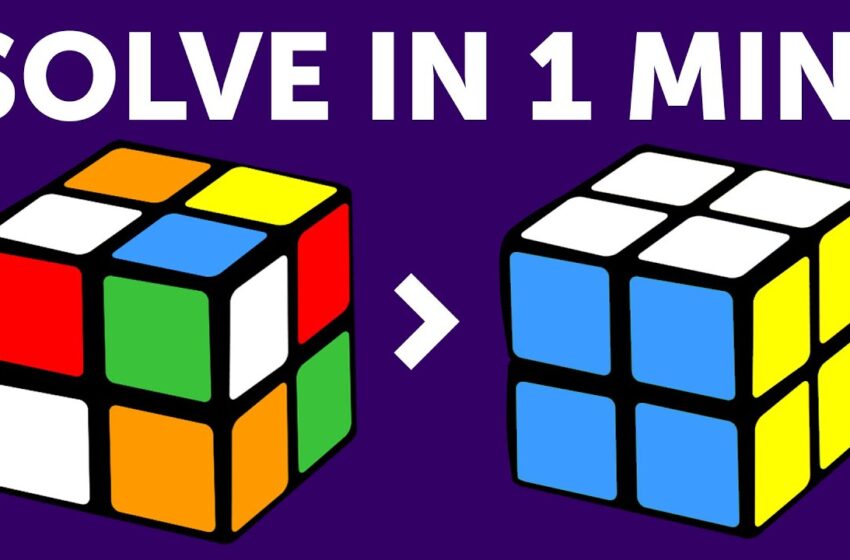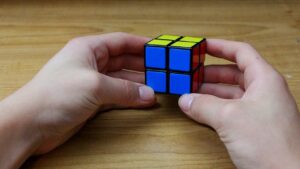How to solve a 2×2 for beginners?

Even the 2x2x2 has motivated lots of designers and a lot of variants and contour mods had been generated as 1981 as noticed over the film.
Beginning the upper left with a center-shifted two coloration Meffert’s Pocket Cube from Justin Eplett which fundamentally will be really a 2×2 at a 2×2. Even the Pyramorphix isn’t really a 2×2 Pyraminx however in fact it is really a wise mod in which you need to be worried regarding the orientation of just 4 bits. At the proper, manhood of this Mad Heads zombie show that shows that any contour might be constructed onto the center with this block. 2×2 puzzles are offered within the form of animation characters, probably the most usual being that the Homer Simpson head.
After having a non-twisty slipping puzzle, the Interior out 2x2x2 (or even Vadász Kocka) that acts as a 3 d 15-Puzzle. A tiny Siamese (Triamese) mystery at which about three cubes are still sharing their corner bits.

how to solve a 2×2 Cube?
This really is a simple 2×2 Rubik’s Cube tutorial, even at which that you never will need to know movement notation or extended calculations.
With exercise, you need to readily have the ability to fix the block within 1 minute. In the event you would like to acquire more quicker, then you should know The best way exactly to accomplish Finger methods along with advanced level 2×2 Techniques.
To begin with, we must realize a 2×two Cube is but a three ×3 with no guts and also Edge bits. It truly is only the Corners of the three ×3 helping to make it a lot easier in all respects.
Such as for instance a three ×3, a2 ×two Cube has 6 sides of distinct colors however similar to a three ×3 that the coloration of those sides isn’t depending on Center bits. For the Large part, the colors really are standardized using all the opposite White, Blue reverse Green and Orange reverse Red. It really is essential for recognition and familiarity.
Right here we really have a disassembled 2 Cube, here can be the 8 and Core fur bits. Just about every Corner includes 3 hues. (Demonstrate eliminated corner bits chucked on a desk such as at 3×3 vid)
Even the 2x2x2 Rubik’s block, or from its own official title – that the Pocket Cube, is just another mystery from the Rubik’s block collection, devised by Erno Rubik. It’s regarded that the”straightforward” variant of this Rubik’s block. You may see out that fixing the exact 2×2 block is a lot easier than fixing the traditional 3x3x3 block.
In the event that you know just how exactly to fix the 3×3 Rubik’s block.
In the event that you are already able to How to solve a 2×2, subsequently blessed you personally – you know just how exactly to address a 2×2 block! Here’s really a wonderful view of this mystery: that the 2×2 block is clearly a normal 3×3 block, minus the borders and also the center bits. Thus ostensibly adjusting the 2×2 block would be equal to fixing the corners of this 3×3. You’re going to be astonished that a few of the calculations you will need to understand are equal to all those you may need to be able to address the 2×2 block, and also you also already recognize most of them should you know about this speedsolving system.
Prior to starting up the response manual, be certain that you know that the Rubik’s block shift notations. For 2×2, the notations are Just the same (same faces, equal letters, the Sam E block rotations, only with no”center layer goes” — because there are aren’t like from the 2×2 block )
The 2×2 Rubik’s Cube alternative
Measure 1 ): Overcoming the Very First coating
This measure is equal to measure a few of this 3×3 block remedy. Pick a shade to get started using (popular coloration to get started using is either white or black yellowish — During this specific guide I picked yellowish ). Pick a large part that’s this shade (yellowish within our instance ), and then draw another 3 corner bits for it. Be certain you remedy the corner bits right in connection with each other (additionally the negative hues of this corner bits need to fit every other, but maybe not just the yellowish. Watch picture – right/wrong).
You will find just 3 Distinct instances to Fix a corner bit to the right posture without damaging another corner:
Measure 2: Orienting the previous layer bits
twist the block upsidedown (the resolved coating should really be at the floor today ). Inside this measure, the aim is always to orient the previous layer bits. The end result ought to be the contrary color for this color we’ve started using will soon be done (Within our instance: exactly the contrary color to yellowish is whitened ). Be aware that not like step one, right here the permutation of those corners will perhaps not thing, that means they don’t really possess to become properly resolved in connection with each other (facet decals do not need to suit ).
You will find just 7 potential instances of past layer orientations (maybe not adding the oriented instance ):
(The grey color usually means that the decal isn’t the top face shade. The pubs into the sides reveal at which the top confront color is everywhere. Inside our instance, it truly is white, yellow. It will not matter naturally )
It’s better to master all of the aforementioned calculations. But, it’s likely to wholly work out this measure with just inch principle — even the very first algorithm. The point is always to do this algorithm from other angles before its acceptable case turns up, then implement it more time and then solve the following step. It’s likely to fix all probable cases over 3 executions, or two in the event that you utilize also its mirror algorithm (instance no 2).
The very first algorithm orients 3 corners leaves and leaves the 4th corner undamaged (its own mirror algorithm, instance Number 2, will not exactly the exact same, however clock-wise ). Before implementing, decide to try to consider by which angle implementing this algorithm will probably render just inch oriented corner (may be carried out over inch implementation from many scenarios ), compared to only employ the appropriate algorithm (instance no 1 ) or 2). It’s possible for you to perform algorithm no inch double as an alternative of using no two strategies if it is desired (at an event a clockwise rotation essential (instance no 2). DO-ing so two to your corners will probably be like carrying out a clockwise orientation, that can clear up them)
Notice that the 6 of those 7 calculations are just the exact calculations used from the speedsolving procedure for this Rubik’s block. You may easily see it’s exactly the exact same 7 potential circumstances when most of the borders of the 3×3 are oriented: OLL calculations web page. But Because There Are Not Any advantages to conserve, we could utilize shorter calculations from Some Other Instances of the Standard OLL of this 3×3 Rubik’s block, Provided That they rotate both the corners because we desire:

For your initial instance, the finest algorithm would be your anti-Sune (OLL algorithm #26)
For your 2nd instance, the greatest algorithm would be your Sune (OLL algorithm # 2 27)
The 3rd instance is unique: a much briefer algorithm could be implemented, that will exist at the 3×3 OLL, nevertheless, OLL algorithm #2-1 Is Quite fine )
For your fourth instance, greatest algorithm Is the Simplest L (OLL algorithm # 2 4-8 )
For your fifth instance, greatest algorithm Is the Initial T (OLL algorithm # 1 4 5 )
For your own first situation, the greatest algorithm would be your next T (OLL algorithm # 1 3 3 )
Your seventh instance, greatest algorithm Is the Initial Fish (OLL algorithm # 1 3-7 )
Measure 3 (and continue ): Permuting the Previous layer bits
Inside this measure, the aim is always to permute the previous coating bits in order that they are going to even be properly calibrated regarding one another, and maybe not correctly oriented. This measure is quite like measure 5 of this 3×3 remedy (newcomer’s procedure ) (-the exact same algorithm might be implemented, it’s only that one that I reveal permutes the corners and not counter-clockwise).
The best way to work out this way is by simply searching for two corners which are properly permuted regarding each other (is readily realized from the simple fact 2 properly calibrated corners in connection with each individual gets precisely the very same color in their common head. Search for equal coloration in two adjoining corners). In the event you have two corners that are properly permuted, simply implement the next algorithm beneath in some other angle which you would like. Then implementation, two properly permuted corners are going to appear.
Subsequently:
Do some turns the two adjoining sam-e colors may lineup by using their coloration at the ground coating. Rotate the block to ensure solved color is likely to soon be around the most suitable encounter – watch image over.
Can U’ formerly.
The consequence of the movement is the fact that the front-left corner may end up”solved” today, and also the 3 additional corners will take a clockwise turning between these. This really is just what the second algorithm will.
Split the subsequent algorithm: (Here really is actually the Aa-perm algorithm. L’ substituted for L’ as no mid coating )
More resource: What are the Rubik’s cube patterns?
